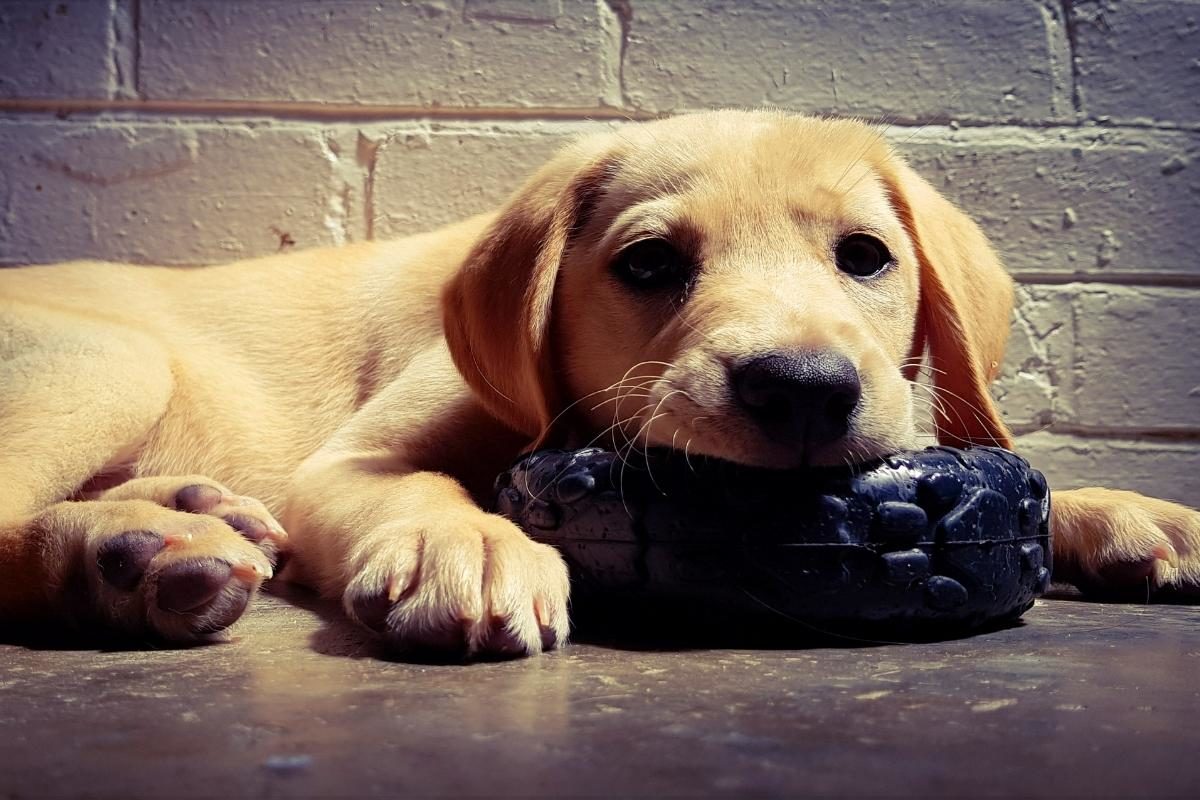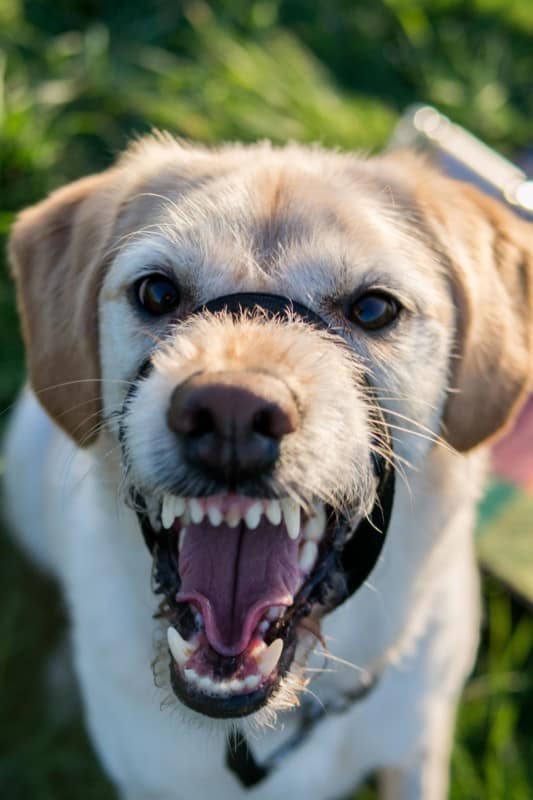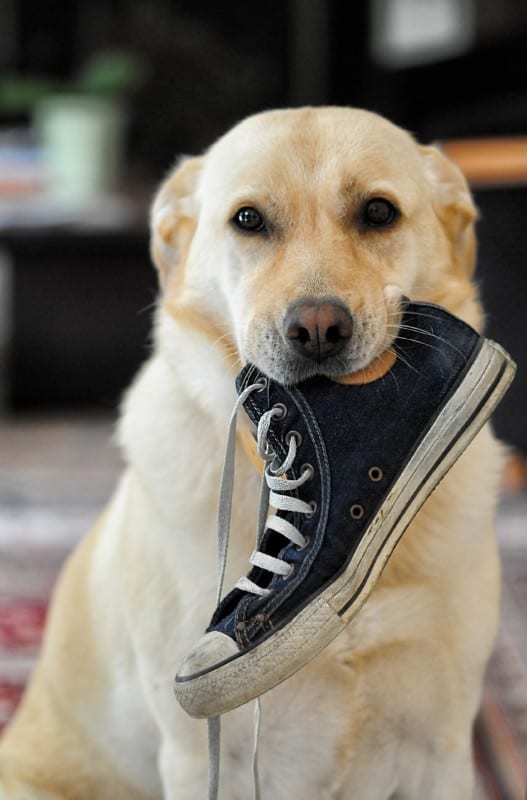Does your Labrador Retriever growl when you get close to him during meals or ingest food rapidly when other dogs are in sight? Does he position his head so he hides his toys or items taken from you like shoes or snarl at friends when they visit and sit next to you on the couch? If yes, then your Labrador could be portraying resource guarding behavior.
Resource guarding, sometimes called possessive aggression, is an innate behavior in dogs used to control access to food, toys, space, or people close to them. Because dogs perceive these items as valuable, they often portray aggressive guarding behavior like snarling, growling, and biting.
So, how do you know that your Labrador Retriever has resource guarding behavior? Reading this article will tell you how. We’ll start you off with the signs of resource guarding then guide you on how to manage and stop this behavior in your dog.

Signs of Labrador Resource Guarding
In the canine world, resource guarding is a crucial natural behavior for survival. A dog in the wild would have to protect their prey from other carnivorous animals to survive.
Because dogs now live with us and don’t have to hunt or guard food and other resources to survive, portraying resource guarding behavior in Labradors and other dogs is considered undesirable.
A study on the adoption success of shelter dogs with resource guarding behavior showed that dogs with severe guarding behavior were most likely to be returned to shelters by their adopters.
Here are 13 of the most common resource guarding behaviors. Labradors will use these behaviors to tell you and other people or animals to stay off their stuff:
- Snapping – Your Labrador makes a sudden movement with the head while closing the teeth and makes a click sound. He snaps to show that he feels threatened and you should not touch his possessions.
- Growling – Aggressive, loud growling (not during play) is probably the most common clear sign of aggression, even in dog resource guarding behavior. It’s often accompanied by lunging and raised hackles.
- Low growling – Manifests as a deep rumbling when your Lab feels that his resources are threatened or that you or another person or dog is encroaching his space. You can think of it as a polite warning to stay away before the real growling, or the worst comes your way.
- Burying or hiding objects – This is a common sign of Labrador food guarding, inherited from the wolf’s hoarding behavior. Dogs, like wolves, bury away food for future access, which can escalate to scatter hoarding in dogs. In other words, your Lab buries or hides food or toys in different places inside and outside the home.
- Stiffening their body over an item – Your Lab becomes very still and rigid with his body over the item being guarded to warn that touching the item is looking for danger.
- Hard stare – Your Labrador stares in a way that almost only the white part of the eye shows, what some will call the “whale eye.” You can learn more about Labrador body language in this article.
- Side eye staring – To track the movement of the person or dog that’s closing in on their possessions.
- Lifted lips and bared teeth – Often used by a dog to send you a clear message to stay away or back off. Bared teeth often precede extreme aggression in dogs.
- Positioning their head or body to hide or control an item – Your Labrador can place his head over a ball, hide a toy between his front legs while lying down and hiding it with his head (bracing position), or horizontally block a path that leads to a valuable object.
- Changing the location of an item – Your Lab may move an item he likes to a different location to hide it from you or other people. It could be a shoe ‘stolen’ from you, and you look for it forever.
- Eating or ingesting food or items rapidly – Your Labrador Retriever could eat extremely fast when other dogs are around or quickly ingest tiny pieces of toys when you try to take them away from him.
- Chasing – Your Lab may chase you or someone who tries to touch something he’s guarding or who comes close to a guarded space like his cage.
- Biting – It’s an extreme sign in resource guarding behavior. Biting can be once or repeated, causing bruises or puncture wounds.
Although not all of these resource guarding behaviors are aggressive, Labradors and other dogs portraying possessive aggression can be a risk to family members and strangers. The most vulnerable people to dog resource guarding aggression are children and those unskilled in canine communication behavior.
As such, it’s important to manage and tame resource guarding in Labradors as soon as you notice it.
Watch How To Stop Resource Guarding In Dogs…
Dealing With Labrador Resource Guarding
Training your Lab to stop resource guarding is the best way to tame the behavior. In addition, there are things you should do or not do when managing your Labrador resource guarding.
Training Your Lab To Stop Resource Guarding
Dog experts recommend hiring the services of a professional dog trainer or behaviorist for Labrador resource guarding training. Doing it by yourself can be dangerous, especially if your Labrador has severe resource guarding or there’s the risk of bites.
However, if your Labrador’s resource guarding is mild, the most recommended approach is desensitization and counterconditioning training.
The 3 main goals in this training are to:
- Expose your Labrador to the resource-guarding stimulus, beginning at a low intensity and graduating to higher intensities (Desensitization).
- Train the dog to replace the tensed emotional response towards the stimulus with a relaxed emotional response (Counterconditioning).
- Teach the Labrador to display the desired behavior instead of the undesired one through positive reinforcement (Response substitution).
You can check the general desensitization and counterconditioning training phases on the Animal Humane Society page.

Here’s how to teach your Labrador to stop resource guarding using desensitization and counterconditioning training:
- Study your Labrador’s resource guarding distance; the distance at which your dog begins to manifest the signs of resource guarding. Some dogs show these signs when you’re only a few feet away, while others do so when you’re in the same room.
Establish the distance at which your Lab doesn’t get tense, and start the training from that point.
- If your Labrador guards his food during meals, serve him his dinner at the usual time and walk away.
- Find a treat that your Labrador loves more than the object he’s guarding. It could be his favorite chew or a piece of chicken steak.
- Begin to approach after a while and stop just before crossing the distance where your dog begins to show signs of resource guarding.
- Toss a piece of his preferred treat to your Lab, and repeat a few times. Then leave quietly.
- Repeat this every time you notice Labrador food aggression signs or resource guarding for toys and other items.
- After 3 to 4 sessions, start to approach for a few steps at a time, then toss the treat. Coming closer reduces the distance at which your Labrador begins to show resource guarding warnings.
- Continue with the sessions until you can finally feed your dog their favorite treat while next to them.
- Try taking away your Lab’s food bowl once he picks the treat. Stay alert that your dog doesn’t make an unexpected aggressive reaction.
If your Labrador lets you take the bowl, praise and reward him, then give back his food bowl right away. Repeat these steps until your Lab learns that he doesn’t need to guard his food.
A WORD OF CAUTION: You shouldn’t rush this process! If you approach your Labrador and he regresses by resuming the signs of aggressive possession, retreat to the distance where he doesn’t show these signs and resume the training from there. If the training is taking too long with no progress, seek the services of a professional dog behaviorist or trainer.
Even with the help of a trainer, there are other do’s and don’ts you should always keep in mind.
Labrador Resource Guarding Do’s
Labrador resource guarding ‘Do’s’ are choices associated with the environment or how you relate with your dog, which helps prevent or manage resource guarding behavior.
Consider these 5 Labrador resource guarding ‘Do’s’:
- Do manage the resource guarding enabling environment: You can do this by identifying all the items or spaces towards which your Labrador guards and removing the unnecessary ones. For example, you can eliminate your dog’s access to your shoes if he tends to take and guard them.
- Do adjust moderately to your dog’s preferences: For things you can’t change like feeding your Lab and leaving his bowls around, adapt to your dog’s desire to eat in peace. You can build the habit of feeding your Lab in his cage, so no one disturbs him there. This way, he won’t feel the need to guard his food.
Feeding your Labrador in his crate is especially important for homes with children. Also, if you have more than one dog, feed them separately.
- Do ensure your dog is well-trained in obedience cues: You should train your Lab in relevant obedience cues during puppyhood and consistently reinforce them after initial training. Check out my Lab puppy training schedule which tells you what to teach month by month.
If your Lab has signs of resource guarding, ensure he still heeds these obedience cues:
- Leave it!
- Drop it!
- Reliable recall (come!)
- Stationing (asking your Lab to move from one place to another. For example, move from the couch to the mat when there are visitors).
If your Labrador has problems obeying any of these, retrain or have a professional trainer refresh his adherence to these commands.
- Do properly socialize your Lab at an early age: This will help your pup interact with other pets and people as possible or actual friends and not threats to his food, space, or family.
- Do exercise your Lab appropriately: Labradors are high-energy dogs, and as they say, a tired dog is a happy dog. Ensuring that your Lab is well-exercised reduces the energy he would invest in inappropriate behavior like guarding resources. It also serves as bonding time between you and your Lab, giving your furry friend a feeling of security.

Labrador Resource Guarding Don’ts
Here are 5 of the most effective Labrador resource guarding ‘Don’ts’:
- Don’t punish the behavior: If your Labrador growls, hides food or toys, or shows bared teeth to protect his food, toys, cage, or other objects and spaces, don’t punish him by hitting or shouting.
Aversive treatment for resource guarding will only make your Labrador more protective of the items. He may think the threat is even greater and portray worse possessive aggression behavior like biting the next time you reach out for his stuff. You can learn tons more in this article, How to Discipline a Labrador: And What Not to Do!
- Don’t create the situations for resource guarding: Dogs often develop resource guarding behavior because the conditions are favorable. For example, if you know that your Lab finds your sneakers valuable to guard, leaving them lying around will only give him the ok to do so. Instead, leave your shoes in a location that’s not accessible to your dog.
- Don’t instill fear in your dog: Resource guarding in dogs has been associated with fear. A study found that dogs with high levels of fear were more likely to show resource guarding behavior than their calmer conspecifics.
- Don’t try to be brave to show who’s boss: This one is for your own safety. Some dog owners may try to be brave by getting close to their Lab when he’s feeding and portraying resource guarding behavior or even taking their dog’s bowl. It will only make your Lab more defensive and may leave you a wounded soldier rather than the boss you were trying to be.
- Don’t stop training your Lab: Dogs can easily go back to undesirable behavior if they realize that you’re not consistent, and they can get away with it. If you have taken the time to train your Labrador to stop possessive guarding, keep insisting on the learned behavior to keep your Lab from falling back into the behavior.
Your dog should consistently know that he doesn’t need to guard his food or other stuff and space.
Above all, never ignore resource guarding behavior in your Lab. Instead, address it as soon as he begins to show the signs explained earlier.
Key Takeaways
Resource guarding in Labradors is natural. However, that shouldn’t imply that your Labrador can possessively guard food, toys, spaces, or people to the point of being aggressive.
If your Labrador growls, snaps, shows bared teeth, places his head on items or bites when things he considers valuable are touched or taken, he is portraying signs of Labrador resource guarding behavior.
Train your Labrador to stop resource guarding through desensitization and counterconditioning. If you’re not up to the task, hire the services of a professional trainer or behaviorist, and don’t risk an ugly dog bite.





